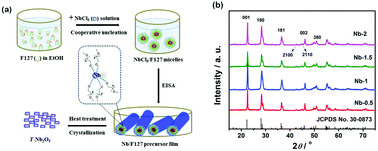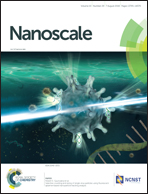T-Nb2O5 nanoparticle enabled pseudocapacitance with fast Li-ion intercalation†
Abstract
Orthorhombic Nb2O5 (T-Nb2O5) nanocrystallites are successfully fabricated through an evaporation induced self-assembly (EISA) method guided by a commercialised triblock copolymer – Pluronic F127. We demonstrate a morphology transition of T-Nb2O5 from continuous porous nanofilms to monodisperse nanoparticles by changing the content of Pluronic F127. The electrochemical results show that the optimized monodisperse Nb-2 with a particle size of 20 nm achieves premier Li-ion intercalation kinetics and higher rate capability than mesoporous T-Nb2O5 nanofilms. Nb-2 presents an initial intercalation capacity of 528 and 451 C g−1 at current densities of 0.5 and 5 A g−1 and exhibited a stable capacity of 499 C g−1 after 300 charge/discharge cycles and 380 C g−1 after 1000 cycles, respectively. We would expect this copolymer guided monodispersion of T-Nb2O5 nanoparticles with high Li+ intercalation performance to open up a new window for novel EES technologies.



 Please wait while we load your content...
Please wait while we load your content...